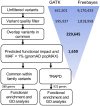Whole exome sequencing study identifies candidate loss of function variants and locus heterogeneity in familial cholesteatoma
- PMID: 36920900
- PMCID: PMC10016674
- DOI: 10.1371/journal.pone.0272174
Whole exome sequencing study identifies candidate loss of function variants and locus heterogeneity in familial cholesteatoma
Abstract
Cholesteatoma is a rare progressive disease of the middle ear. Most cases are sporadic, but some patients report a positive family history. Identifying functionally important gene variants associated with this disease has the potential to uncover the molecular basis of cholesteatoma pathology with implications for disease prevention, surveillance, or management. We performed an observational WES study of 21 individuals treated for cholesteatoma who were recruited from ten multiply affected families. These family studies were complemented with gene-level mutational burden analysis. We also applied functional enrichment analyses to identify shared properties and pathways for candidate genes and their products. Filtered data collected from pairs and trios of participants within the ten families revealed 398 rare, loss of function (LOF) variants co-segregating with cholesteatoma in 389 genes. We identified six genes DENND2C, DNAH7, NBEAL1, NEB, PRRC2C, and SHC2, for which we found LOF variants in two or more families. The parallel gene-level analysis of mutation burden identified a significant mutation burden for the genes in the DNAH gene family, which encode products involved in ciliary structure. Functional enrichment analyses identified common pathways for the candidate genes which included GTPase regulator activity, calcium ion binding, and degradation of the extracellular matrix. The number of candidate genes identified and the locus heterogeneity that we describe within and between multiply affected families suggest that the genetic architecture for familial cholesteatoma is complex.
Copyright: © 2023 Cardenas et al. This is an open access article distributed under the terms of the Creative Commons Attribution License, which permits unrestricted use, distribution, and reproduction in any medium, provided the original author and source are credited.
Conflict of interest statement
The authors have declared that no competing interests exist.
Figures




Similar articles
-
Identification of candidate cancer predisposing variants by performing whole-exome sequencing on index patients from BRCA1 and BRCA2-negative breast cancer families.BMC Cancer. 2019 Apr 4;19(1):313. doi: 10.1186/s12885-019-5494-7. BMC Cancer. 2019. PMID: 30947698 Free PMC article.
-
Whole-exome sequencing of 81 individuals from 27 multiply affected bipolar disorder families.Transl Psychiatry. 2020 Feb 4;10(1):57. doi: 10.1038/s41398-020-0732-y. Transl Psychiatry. 2020. PMID: 32066727 Free PMC article.
-
Whole exome sequencing identifies PLEC, EXO5 and DNAH7 as novel susceptibility genes in testicular cancer.Int J Cancer. 2018 Oct 15;143(8):1954-1962. doi: 10.1002/ijc.31604. Epub 2018 Aug 9. Int J Cancer. 2018. PMID: 29761480
-
Whole-exome sequencing of familial cases of multiple morphological abnormalities of the sperm flagella (MMAF) reveals new DNAH1 mutations.Hum Reprod. 2016 Dec;31(12):2872-2880. doi: 10.1093/humrep/dew262. Epub 2016 Oct 26. Hum Reprod. 2016. PMID: 27798045
-
Exome sequencing of Japanese schizophrenia multiplex families supports the involvement of calcium ion channels.PLoS One. 2022 May 10;17(5):e0268321. doi: 10.1371/journal.pone.0268321. eCollection 2022. PLoS One. 2022. PMID: 35536790 Free PMC article.
Cited by
-
Deleterious ZNRF3 germline variants cause neurodevelopmental disorders with mirror brain phenotypes via domain-specific effects on Wnt/β-catenin signaling.Am J Hum Genet. 2024 Sep 5;111(9):1994-2011. doi: 10.1016/j.ajhg.2024.07.016. Epub 2024 Aug 20. Am J Hum Genet. 2024. PMID: 39168120 Free PMC article.
-
Editorial: Otitis media susceptibility due to genetic variants.Front Genet. 2023 Dec 12;14:1341669. doi: 10.3389/fgene.2023.1341669. eCollection 2023. Front Genet. 2023. PMID: 38152651 Free PMC article. No abstract available.
-
Functional Studies of Deafness-Associated Pendrin and Prestin Variants.Int J Mol Sci. 2024 Feb 27;25(5):2759. doi: 10.3390/ijms25052759. Int J Mol Sci. 2024. PMID: 38474007 Free PMC article.
References
-
- Hospital Episode Statistics (HES) [Internet]. 2021. https://digital.nhs.uk/data-and-information/data-tools-and-services/data....
Publication types
MeSH terms
LinkOut - more resources
Full Text Sources

